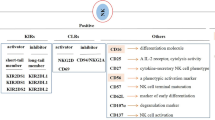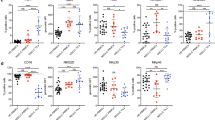Abstract
Natural killer (NK) cells play a crucial role in the anti-tumor transaction through cytolytic activity with the help of proportionate expression of their activating receptors (ARs) and inhibitory receptors (IRs). The proliferation, differentiation, and effector’s functions of NK cells were affected and regulated by CD4+CD25+ regulatory T (Treg) cells through the NKG2D receptor expressed on NK cells. It has not yet been established whether Treg cells also affects the expression and functions of other receptors of NK cell. Moreover, the effect of cyclophosphamide (CYP) treatment on the expression and functions of AR and IR receptors of NK cells regulated by Treg cells during cancer progression is not clearly understood. Therefore, we have used the metronomic dose of CYP and anti-CD25 and anti-TGF-β to inhibit the effects of Treg cells in DL-induced tumor microenvironment and analyze the expression of ARs and IRs on NK cells and the FoxP3 level on Treg cells. It was observed that treatment of CYP and blocking antibodies not only affects the functions of tumor-associated NK cells (TANK cells) by modulating the expression of ARs and IRs in DL-induced tumor microenvironment, but also downregulates the functions of Treg cells. The findings of our study supported and suggested that the use of CYP in combination with other therapeutic approaches will effectively reduce tumor growth directly and/or indirectly by modulating the NK cell-mediated immune response of the host.









Similar content being viewed by others
References
Vitale M et al (2014) Effect of tumor cells and tumor microenvironment on NK-cell function. Eur J Immunol 44(6):1582–1592
Han B et al (2018) Altered NKp30, NKp46, NKG2D, and DNAM-1 expression on circulating NK cells is associated with tumor progression in human gastric cancer. J Immunol Res 2018:6248590
Garcia-Iglesias T et al (2009) Low NKp30, NKp46 and NKG2D expression and reduced cytotoxic activity on NK cells in cervical cancer and precursor lesions. BMC Cancer 9:186
Sandoval-Borrego D et al (2016) Overexpression of CD158 and NKG2A inhibitory receptors and underexpression of NKG2D and NKp46 activating receptors on NK cells in acute Myeloid Leukemia. Arch Med Res 47(1):55–64
Zhang X et al (2019) Synergized regulation of NK cell education by NKG2A and specific Ly49 family members. Nat Commun 10(1):5010
Wai LE et al (2011) Distinct roles for the NK cell-activating receptors in mediating interactions with dendritic cells and tumor cells. J Immunol 186(1):222–229
French AR, Yokoyama WM (2004) Natural killer cells and autoimmunity. Arthritis Res Ther 6(1):8–14
Tomar MS et al (2018) NK cell effector functions regulation by modulating nTreg cell population during progressive growth of Dalton’s lymphoma in mice. Immunol Invest 47(1):40–56
Bergmann C et al (2011) Human tumor-induced and naturally occurring Treg cells differentially affect NK cells activated by either IL-2 or target cells. Eur J Immunol 41(12):3564–3573
Ghiringhelli F et al (2005) CD4+CD25+ regulatory T cells inhibit natural killer cell functions in a transforming growth factor-beta-dependent manner. J Exp Med 202(8):1075–1085
Jewett A, Man YG, Tseng HC (2013) Dual functions of natural killer cells in selection and differentiation of stem cells; role in regulation of inflammation and regeneration of tissues. J Cancer 4(1):12–24
Ralainirina N et al (2007) Control of NK cell functions by CD4+CD25+ regulatory T cells. J Leukoc Biol 81(1):144–153
Curiel TJ (2007) Regulatory T-cell development: is Foxp3 the decider? Nat Med 13(3):250–253
Attias M, Al-Aubodah T, Piccirillo CA (2019) Mechanisms of human FoxP3(+) Treg cell development and function in health and disease. Clin Exp Immunol 197(1):36–51
Yun X, Shang Y, Li M (2015) Effect of Lactobacillus salivarius on Th1/Th2 cytokines and the number of spleen CD4(+) CD25(+) Foxp3(+) Treg in asthma Balb/c mouse. Int J Clin Exp Pathol 8(7):7661–7674
Karanikas V et al (2008) Foxp3 expression in human cancer cells. J Transl Med 6:19
Tongu M et al (2013) Metronomic chemotherapy with low-dose cyclophosphamide plus gemcitabine can induce anti-tumor T cell immunity in vivo. Cancer Immunol Immunother 62(2):383–391
Man S et al (2002) Antitumor effects in mice of low-dose (metronomic) cyclophosphamide administered continuously through the drinking water. Cancer Res 62(10):2731–2735
Lutsiak ME et al (2005) Inhibition of CD4(+)25+ T regulatory cell function implicated in enhanced immune response by low-dose cyclophosphamide. Blood 105(7):2862–2868
Ding ZC, Munn DH, Zhou G (2014) Chemotherapy-induced myeloid suppressor cells and antitumor immunity: The Janus face of chemotherapy in immunomodulation. Oncoimmunology 3(8):e954471
Luznik L, Fuchs EJ (2010) High-dose, post-transplantation cyclophosphamide to promote graft-host tolerance after allogeneic hematopoietic stem cell transplantation. Immunol Res 47(1–3):65–77
Ghiringhelli F et al (2007) Metronomic cyclophosphamide regimen selectively depletes CD4+CD25+ regulatory T cells and restores T and NK effector functions in end stage cancer patients. Cancer Immunol Immunother 56(5):641–648
Oh E, et al (2019) Erratum: Oh E, et al. Cryopreserved human natural killer cells exhibit potent antitumor efficacy against orthotopic pancreatic cancer through efficient tumor-homing and cytolytic ability (Running Title: Cryopreserved NK Cells Exhibit Antitumor Effect). Cancers 2019, 11, 966. Cancers (Basel), 2020. 12(11).
Choudhury B et al (2016) Anticancer activity of Garcinia morella on T-cell murine lymphoma via apoptotic induction. Front Pharmacol 7:3
Sharma G et al (2017) p53 dependent apoptosis and cell cycle delay induced by heteroleptic complexes in human cervical cancer cells. Biomed Pharmacother 88:218–231
Valiathan R et al (2012) Evaluation of a flow cytometry-based assay for natural killer cell activity in clinical settings. Scand J Immunol 75(4):455–462
Lee J et al (2017) Natural killer cell activity for IFN-gamma production as a supportive diagnostic marker for gastric cancer. Oncotarget 8(41):70431–70440
Tallerico R et al (2013) Human NK cells selective targeting of colon cancer-initiating cells: a role for natural cytotoxicity receptors and MHC class I molecules. J Immunol 190(5):2381–2390
Nieto-Velazquez NG et al (2016) Altered expression of natural cytotoxicity receptors and NKG2D on peripheral blood NK cell subsets in breast cancer patients. Transl Oncol 9(5):384–391
Shi L et al (2018) Modulation of NKG2D, NKp46, and Ly49C/I facilitates natural killer cell-mediated control of lung cancer. Proc Natl Acad Sci U S A 115(46):11808–11813
Wang XJ et al (2009) Activated T cells inhibit NK cell-mediated tumour rejection. Scand J Immunol 69(4):337–341
Smyth MJ et al (2004) NKG2D recognition and perforin effector function mediate effective cytokine immunotherapy of cancer. J Exp Med 200(10):1325–1335
Salcedo M et al (1997) Altered expression of Ly49 inhibitory receptors on natural killer cells from MHC class I-deficient mice. J Immunol 158(7):3174–3180
Lanier LL (2008) Up on the tightrope: natural killer cell activation and inhibition. Nat Immunol 9(5):495–502
Vahlne G et al (2008) IFN-gamma production and degranulation are differentially regulated in response to stimulation in murine natural killer cells. Scand J Immunol 67(1):1–11
Lanier LL (2003) Natural killer cell receptor signaling. Curr Opin Immunol 15(3):308–314
Fauriat C et al (2010) Regulation of human NK-cell cytokine and chemokine production by target cell recognition. Blood 115(11):2167–2176
Feng PH et al (2020) NKG2D-Fc fusion protein promotes antitumor immunity through the depletion of immunosuppressive cells. Cancer Immunol Immunother 69(10):2147–2155
Zhou S et al (2013) Depletion of CD4+ CD25+ regulatory T cells promotes CCL21-mediated antitumor immunity. PLoS ONE 8(9):e73952
Scurr M et al (2017) Low-dose cyclophosphamide induces antitumor T-cell responses, which associate with survival in metastatic colorectal cancer. Clin Cancer Res 23(22):6771–6780
Huijts CM et al (2019) The effect of everolimus and low-dose cyclophosphamide on immune cell subsets in patients with metastatic renal cell carcinoma: results from a phase I clinical trial. Cancer Immunol Immunother 68(3):503–515
Geng X et al (2019) CD4+CD25+Foxp3+ regulatory T cells suppress NKG2D-mediated NK cell cytotoxicity in peripheral blood. Medicine (Baltimore) 98(22):e15722
Smyth MJ et al (2005) Activation of NK cell cytotoxicity. Mol Immunol 42(4):501–510
Moretta A et al (2001) Activating receptors and coreceptors involved in human natural killer cell-mediated cytolysis. Annu Rev Immunol 19:197–223
Acknowledgements
We would like to thank the volunteers who participated in this study. The authors are thankful to the coordinator of ISLS, BHU for providing the instrumental facilities. This work was carried out by the grant from the Banaras Hindu University and the University of Grant Commission, Government of India to Prof. Arbind Acharya.
Author information
Authors and Affiliations
Contributions
The experiments of this investigation were designed by MST and AA. MST has performed the experiments. RKS prepared reagents and helped during experiments. The manuscript was written by MST and critically reviewed by RKS, IVU, and AA. Kaushalendra helped during revision and, all authors read the final manuscript and approved it for submission.
Corresponding author
Ethics declarations
Conflict of interest
This research is the part of PhD work of MST. PI had received financial support from UGC, New Delhi, and DST New Delhi. All other co-authors have contributed in performing the experimental design, writing, and critically reviewing the manuscript. On behalf of all the authors, it is declared that there is no any potential conflict of interest and all have given their consent for the publication of the manuscript.
Ethical statement
All animal experiments were performed according to the guidelines given by Institution Animal Ethical Committee (IAEC), Department of Zoology, Banaras Hindu University, Varanasi, India.
Additional information
Publisher's Note
Springer Nature remains neutral with regard to jurisdictional claims in published maps and institutional affiliations.
Rights and permissions
Springer Nature or its licensor (e.g. a society or other partner) holds exclusive rights to this article under a publishing agreement with the author(s) or other rightsholder(s); author self-archiving of the accepted manuscript version of this article is solely governed by the terms of such publishing agreement and applicable law.
About this article
Cite this article
Tomar, M.S., Singh, R.K., Ulasov, I.V. et al. Refurbishment of NK cell effector functions through their receptors by depleting the activity of nTreg cells in Dalton’s Lymphoma-induced tumor microenvironment: an in vitro and in vivo study. Cancer Immunol Immunother 72, 1429–1444 (2023). https://doi.org/10.1007/s00262-022-03339-6
Received:
Accepted:
Published:
Issue Date:
DOI: https://doi.org/10.1007/s00262-022-03339-6




